Comparison of Topographic Roughness of Layered Deposits on Mars
Abstract
1. Introduction
2. Data and Method
2.1. Data
2.2. Method
3. Results
3.1. Topography Roughness Represented by IV3R
3.2. Comparison of Roughness of Lobate Debris Aprons and Long-Runout Landslides on Mars
3.3. Roughness of Layered Ejecta Deposits of Martian Craters
4. Discussion
4.1. A Possible Connection between Topographic Roughness and Emplacement Process of Layered Deposits on Mars
4.2. Heterogeneous Roughness for Layered Ejecta Deposits on Mars
5. Conclusions
Author Contributions
Funding
Data Availability Statement
Conflicts of Interest
Appendix A
- Root Mean Square Slope (RMS Slope) and Median Different Slope (MDS)
- Interquartile range of Curvature (IQR-C)

References
- Melosh, H.J. Impact Cratering: A Geologic Process; Oxford University Press: NewYork, NY, USA, 1989. [Google Scholar]
- Barlow, N.G. A review of Martian impact crater ejecta structures and their implications for target properties. In Large Meteorite Impacts III; Geological Society of America: Boulder, CO, USA, 2005. [Google Scholar]
- Boyce, J.M.; Mouginis-Mark, P.J. Martian craters viewed by the Thermal Emission Imaging System instrument: Double-layered ejecta craters. J. Geophys. Res. Planets 2006, 111, E10005. [Google Scholar] [CrossRef]
- Boyce, J.; Barlow, N.; Mouginis-Mark, P.; Stewart, S. Rampart craters on Ganymede: Their implications for fluidized ejecta emplacement. Meteorit. Planet. Sci. 2010, 45, 638–661. [Google Scholar] [CrossRef]
- Carr, M.H.; Crumpler, L.S.; Cutts, J.A.; Greeley, R.; Guest, J.E.; Masursky, H. Martian impact craters and emplacement of ejecta by surface flow. J. Geophys. Res. 1977, 82, 4055–4065. [Google Scholar] [CrossRef]
- Barlow, N.G.; Perez, C.B. Martian impact crater ejecta morphologies as indicators of the distribution of subsurface volatiles. J. Geophys. Res. Planets 2003, 108, 27. [Google Scholar] [CrossRef]
- Komatsu, G.; Ori, G.G.; Lorenzo, S.D.; Rossi, A.P.; Neukum, G. Combinations of processes responsible for Martian impact crater layered ejecta structures emplacement. J. Geophys. Res. 2007, 112, e06005. [Google Scholar] [CrossRef]
- Boyce, J.M.; Mouginis-Mark, P.J. Radial grooves on Martian layered ejecta deposits. In Proceedings of the Lunar and Planetary Science XLVIII, Woodlands, TX, USA, 20–24 March 2017. [Google Scholar]
- Boyce, J.M.; Mouginis-Mark, P.J. Morphologic differences in radial grooves on martian layered (fluidized) ejecta: Implications for emplacement processes and conditions. Icarus 2021, 366, 114513. [Google Scholar] [CrossRef]
- Hoover, R.H.; Robbins, S.J.; Putzig, N.E.; Riggs, J.D.; Hynek, B.M. Insight Into Formation Processes of Layered Ejecta Craters on Mars From Thermophysical Observations. J. Geophys. Res. Planets 2021, 126, e2020JE006801. [Google Scholar] [CrossRef]
- Sacks, L.E.; Tornabene, L.L.; Osinski, G.R.; Sopoco, R. Hargraves Crater, Mars: Insights into the internal structure of layered ejecta deposits. Icarus 2022, 375, 114854. [Google Scholar] [CrossRef]
- Barlow, N.G.; Boyce, J.M.; Costard, F.M.; Craddock, R.A.; Garvin, J.B.; Sakimoto, S.E.H.; Kuzmin, R.O.; Roddy, D.J.; Soderblom, L.A. Standardizing the nomenclature of Martian impact crater ejecta morphologies. J. Geophys. Res. Planets 2000, 105, 26733–26738. [Google Scholar] [CrossRef]
- Pietrek, A.; Hergarten, S.; Kenkmann, T. Morphometric Characterization of Longitudinal Striae on Martian Landslides and Impact Ejecta Blankets and Implications for the Formation Mechanism. J. Geophys. Res. Planets 2020, 125, e06255. [Google Scholar] [CrossRef]
- Viola, D.; McEwen, A.S.; Dundas, C.M.; Byrne, S. Expanded secondary craters in the Arcadia Planitia region, Mars: Evidence for tens of Myr-old shallow subsurface ice. Icarus 2015, 248, 190–204. [Google Scholar] [CrossRef]
- Viola, D.; McEwen, A.S.; Dundas, C.M.; Byrne, C.M. Subsurface volatile content of martian double-layer ejecta (DLE) craters. Icarus 2017, 284, 325–343. [Google Scholar] [CrossRef]
- Milliken, R.E. Viscous flow features on the surface of Mars: Observations from high-resolution Mars Orbiter Camera (MOC) images. J. Geophys. Res. 2003, 108, 5057. [Google Scholar] [CrossRef]
- Souness, C.; Hubbard, B.; Milliken, R.E.; Quincey, D. An inventory and population-scale analysis of martian glacier-like form. Icarus 2012, 217, 243–255. [Google Scholar] [CrossRef]
- Shepard, M.K.; Campbell, B.A.; Bulmer, M.H.; Farr, T.G.; Gaddis, L.R.; Plaut, J.J. The roughness of natural terrain: A planetary and remote sensing perspective. J. Geophys. Res. Planets 2001, 106, 32777–32795. [Google Scholar] [CrossRef]
- Wulf, G.; Kenkmann, T. High-resolution studies of double-layered ejecta craters: Morphology, inherent structure, and a phenomenological formation model. Meteorit. Planet. Sci. Planet. Sci. 2015, 50, 173–203. [Google Scholar] [CrossRef]
- Jawin, E.R.; Kiefer, W.S.; Bussey, B.; Cahill, J.T.; Dyar, M.D.; Fassett, C.I.; Spudis, P.D. Analyzing the evolution of surface roughness of lunar mare. In Proceedings of the 43rd Lunar and Planetary Science Conference, Woodlands, TX, USA, 13–23 March 2012. [Google Scholar]
- Pommerol, A.; Chakraborty, S.; Thomas, N. Comparative study of the surface roughness of the Moon, Mars and Mercury. Planet. Space Sci. 2012, 73, 287–293. [Google Scholar] [CrossRef]
- Malamud, B.D.; Turcotte, D.L. Wavelet analyses of Mars polar topography. J. Geophys. Res. 2001, 106, 17497–17504. [Google Scholar] [CrossRef]
- Booth, A.M.; Roering, J.J.; Perron, J.T. Automated landslide mapping using spectral analysis and high-resolution topographic data: Puget Sound lowlands, Washington, and Portland Hills, Oregon. Geomorphology 2009, 109, 132–147. [Google Scholar] [CrossRef]
- Gibbs, J.W. Fourier’s Series. Nature 1899, 59, 606. [Google Scholar] [CrossRef]
- Ma, H.; Qi, D.; Song, R.; Wang, T. The complete orthogonal V-system and its applications. Commun. Pure Appl. Anal. 2007, 6, 853–871. [Google Scholar] [CrossRef]
- Cao, W.; Xiao, Z.; Xu, R.; Wang, Y. Extracting Background Secondary Craters Based on Fusion of Multiscale and Multifacies Crater Topography Information. IEEE Trans. Geosci. Remote Sens. 2022, 60, 3195201. [Google Scholar] [CrossRef]
- Malin, M.C.; Bell, J.F.; Cantor, B.A.; Caplinger, M.A.; Calvin, W.M.; Clancy, R.T.; Edgett, K.S.; Edwards, L.; Haberle, R.M.; James, P.B.; et al. Context Camera Investigation on board the Mars Reconnaissance Orbiter. J. Geophys. Res. 2007, 112, E05S04. [Google Scholar] [CrossRef]
- Robbins, S.J.; Hynek, B.M. A new global database of Mars impact craters ≥1 km: 1. Database creation, properties, and parameters. J. Geophys. Res. Planets 2012, 117, e05004. [Google Scholar] [CrossRef]
- Robbins, S.J.; Hynek, B.M. A new global database of Mars impact craters ≥ 1 km: 2. Global crater properties and regional variations of the simple-to-complex transition diameter. J. Geophys. Res. Planets 2012, 117, e06001. [Google Scholar] [CrossRef]
- Crosta, G.B.; Frattini, P.; Valbuzzi, E.; Blasio, F.V.D. Introducing a New Inventory of Large Martian Landslides. Earth Space Sci. 2018, 5, 89–119. [Google Scholar] [CrossRef]
- Quantin-Nataf, C.; Lozach, L.; Thollot, P.; Loizeau, D.; Bultel, B.; Fernando, J.; Allemand, P.; Dubuffet, F.; Poulet, F.; Ody, A.; et al. MarsSI: Martian surface data processing information system. Planet. Space Sci. 2018, 150, 157–170. [Google Scholar] [CrossRef]
- Volat, M.; Quantin-Nataf, C.; Dehecq, A. Digital elevation model workflow improvements for the MarsSI platform and resulting orthorectified mosaic of Oxia Planum, the landing site of the ExoMars 2022 rover. Planet. Space Sci. 2022, 222, 105552. [Google Scholar] [CrossRef]
- Smith, D.E.; Zuber, M.T.; Frey, H.V.; Garvin, J.B.; Head, J.W.; Muhleman, D.O.; Pettengill, G.H.; Phillips, R.J.; Solomon, S.C.; Zwally, H.J.; et al. Mars Orbiter Laser Altimeter: Experiment summary after the first year of global mapping of Mars. J. Geophys. Res. 2001, 106, 23689–23722. [Google Scholar] [CrossRef]
- Millot, C.; Quantin-Nataf, C.; Leyrat, C.; Lherm, V.; Volat, M. Assessing slope uncertainties of martian Digital Elevation Models from numerical propagation of errors on synthetic geological surfaces. Icarus 2023, 391, 115341. [Google Scholar] [CrossRef]
- Kreslavsky, M.A.; Head, J.W. Kilometer-scale roughness of Mars: Results from MOLA data analysis. J. Geophys. Res. Planets 2000, 105, 26695–26711. [Google Scholar] [CrossRef]
- Grohmann, C.H.; Riccomini, C. Comparison of roving-window and search-window techniques for characterising landscape morphometry. Comput. Geosci. 2009, 35, 2164–2169. [Google Scholar] [CrossRef]
- Kreslavsky, M.A.; Head, J.W.; Neumann, G.A.; Rosenburg, M.A.; Aharonson, O.; Smith, D.E.; Zuber, M.T. Lunar topographic roughness maps from Lunar Orbiter Laser Altimeter (LOLA) data: Scale dependence and correlation with geologic features and units. Icarus 2013, 226, 52–66. [Google Scholar] [CrossRef]
- Sinha, R.K.; Ray, D.; Haas, T.D.; Conway, S.J. Global documentation of overlapping lobate deposits in martian gullies. Icarus 2020, 352, 113979. [Google Scholar] [CrossRef]
- Lemelin, M.; Daly, M.G.; Delige, A. Analysis of the Topographic Roughness of the Moon Using the Wavelet Leaders Method and the Lunar Digital Elevation Model From the Lunar Orbiter Laser Altimeter and SELENE Terrain Camera. J. Geophys. Res. Planets 2020, 125, e06105. [Google Scholar] [CrossRef]
- Amatulli, G.; Domisch, S.; Tuanmu, M.-N.; Parmentier, B.; Ranipeta, A.; Malczyk, J.; Jetz, W. A suite of global, cross-scale topographic variables for environmental and biodiversity modeling. Sci. Data 2018, 5, 180040. [Google Scholar] [CrossRef]
- Freedman, D.; Diaconis, P. On the histogram as a density estimator:L 2 theory. Z. Für Wahrscheinlichkeitstheorie und Verwandte Geb. 1981, 57, 453–476. [Google Scholar] [CrossRef]
- Mouginis-Mark, P. Ejecta emplacment and modes of formation of Martian fluidized ejecta craters. Icarus 1981, 45, 60–76. [Google Scholar] [CrossRef]
- Varnes, D.J. Slope movement types and processes. In Special Report 76: Landslides: Analysis and Control; Schuster, R.L., Krizek, R.J., Eds.; Transportation and Road Research Board, National Academy of Science: Washington, DC, USA, 1978; pp. 11–33. [Google Scholar]
- Blasio, F.V.D. Landslides in Valles Marineris (Mars): A possible role of basal lubrication by sub-surface ice. Planet. Space Sci. 2011, 59, 1384–1392. [Google Scholar] [CrossRef]
- Magnarini, G.; Mitchell, T.M.; Grindrod, P.M.; Goren, L.; Schmitt, H.H. Longitudinal ridges imparted by high-speed granular flow mechanisms in martian landslides. Nat. Commun. 2019, 10, 4711. [Google Scholar] [CrossRef]
- Lucchitta, B.K. Landslides in Valles Marineris, Mars. J. Geophys. Res. 1979, 84, 8097. [Google Scholar] [CrossRef]
- Mazzanti, P.; Blasio, F.V.D.; Bastiano, C.D.; Bozzano, F. Inferring the high velocity of landslides in Valles Marineris on Mars from morphological analysis. Earth Planet Space 2016, 68, 1. [Google Scholar] [CrossRef]
- Mangold, N.; Allemand, P. Topographic analysis of features related to ice on Mars. Geophys. Res. Lett. 2001, 28, 407–410. [Google Scholar] [CrossRef]
- Mangold, N.; Aliemand, P.; Thomas, P.; Duval, P.; Géraud, Y. Experimental and thepretical deformation of ice-rock mixtures: Implications on rheology and ice content of Martian permafrost. Planet. Space Sci. 2002, 50, 385–401. [Google Scholar] [CrossRef]
- Mangold, N. Geomorphic analysis of lobate debris aprons on Mars at Mars Orbiter Camera scale: Evidence for Ice sublimation initiated by fractures. J. Geophys. Res. 2003, 108, 8021. [Google Scholar] [CrossRef]
- Barlow, N.G. Multiple Layer Ejecta. In Encyclopedia of Planetary Landforms; Springer: New York, NY, USA, 2015; pp. 1418–1422. [Google Scholar]
- Mouginis-Mark, P.J.; Sharpton, V.L. The asymmetric ejecta pattern of Zunil crater, Mars. In Proceedings of the 47th Lunar and Planetary Science Conference, Woodlands, TX, USA, 21–25 March 2016. [Google Scholar]
- Mouginis-Mark, P.J.; Boyce, J.M. Tooting crater: Geology and geomorphology of the archetype large, fresh, impact crater on Mars. Geochemistry 2012, 72, 1–23. [Google Scholar] [CrossRef]
- Kokhanov, A.A.; Karachevtseva, I.P.; Zharkova, A. Topographic Roughness as Interquartile Range of the Second Derivatives: Calculation and Mapping. In Lecture Notes in Geoinformation and Cartography; Springer International Publishing: Cham, Switzerland, 2019; pp. 315–324. [Google Scholar]
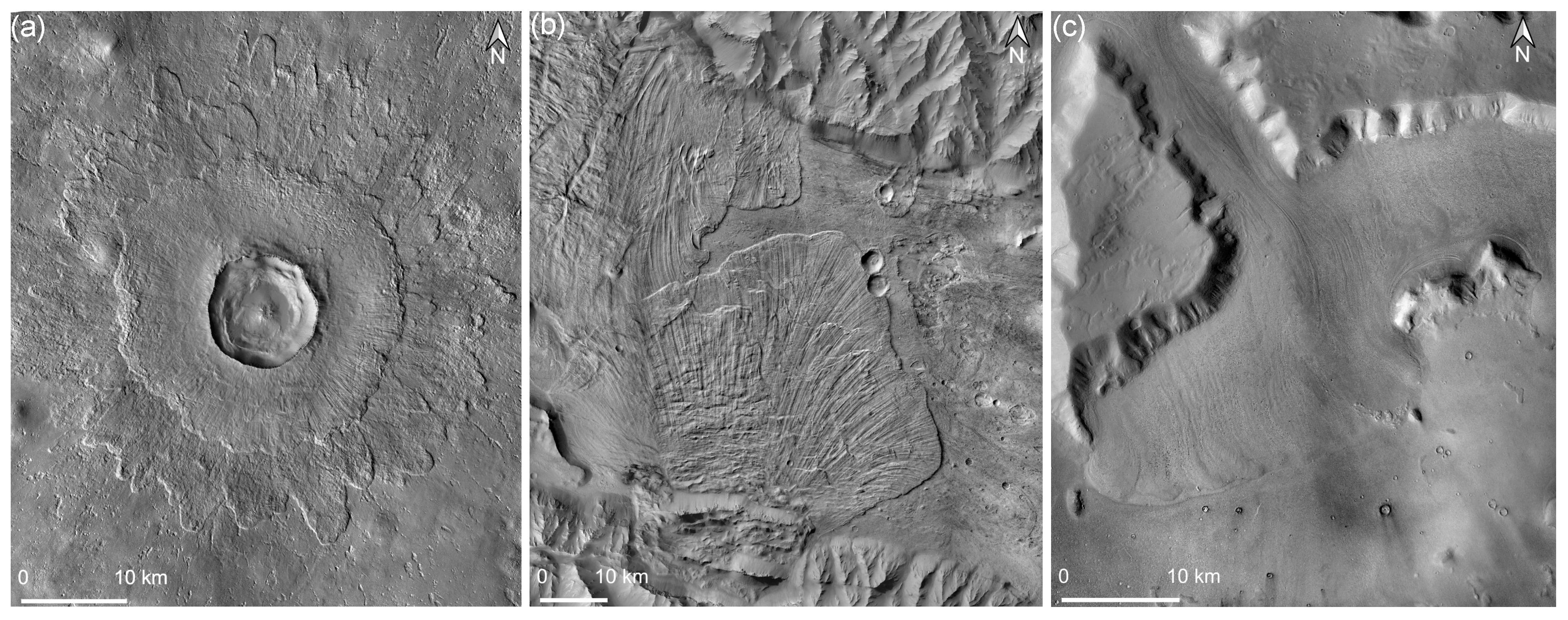
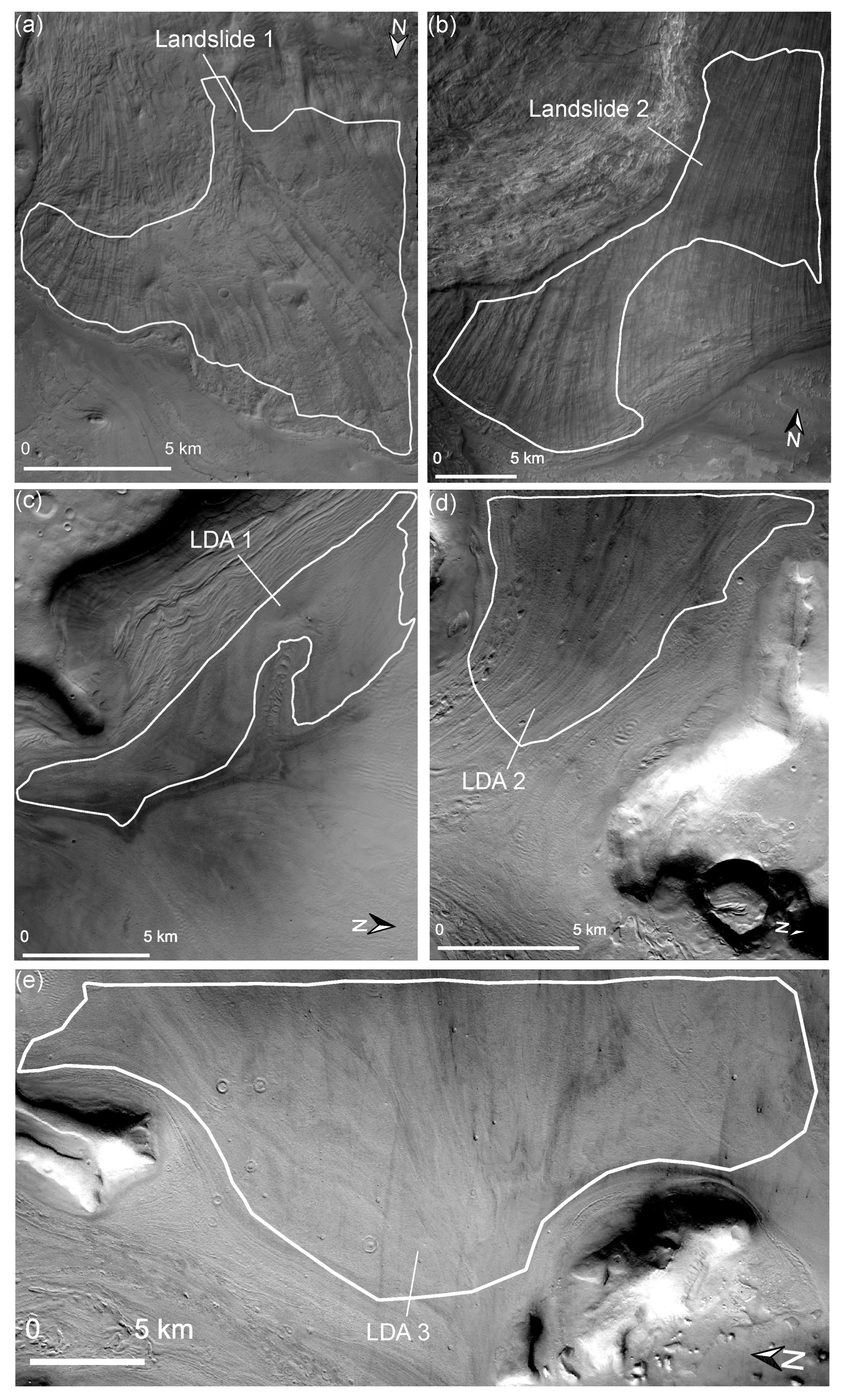
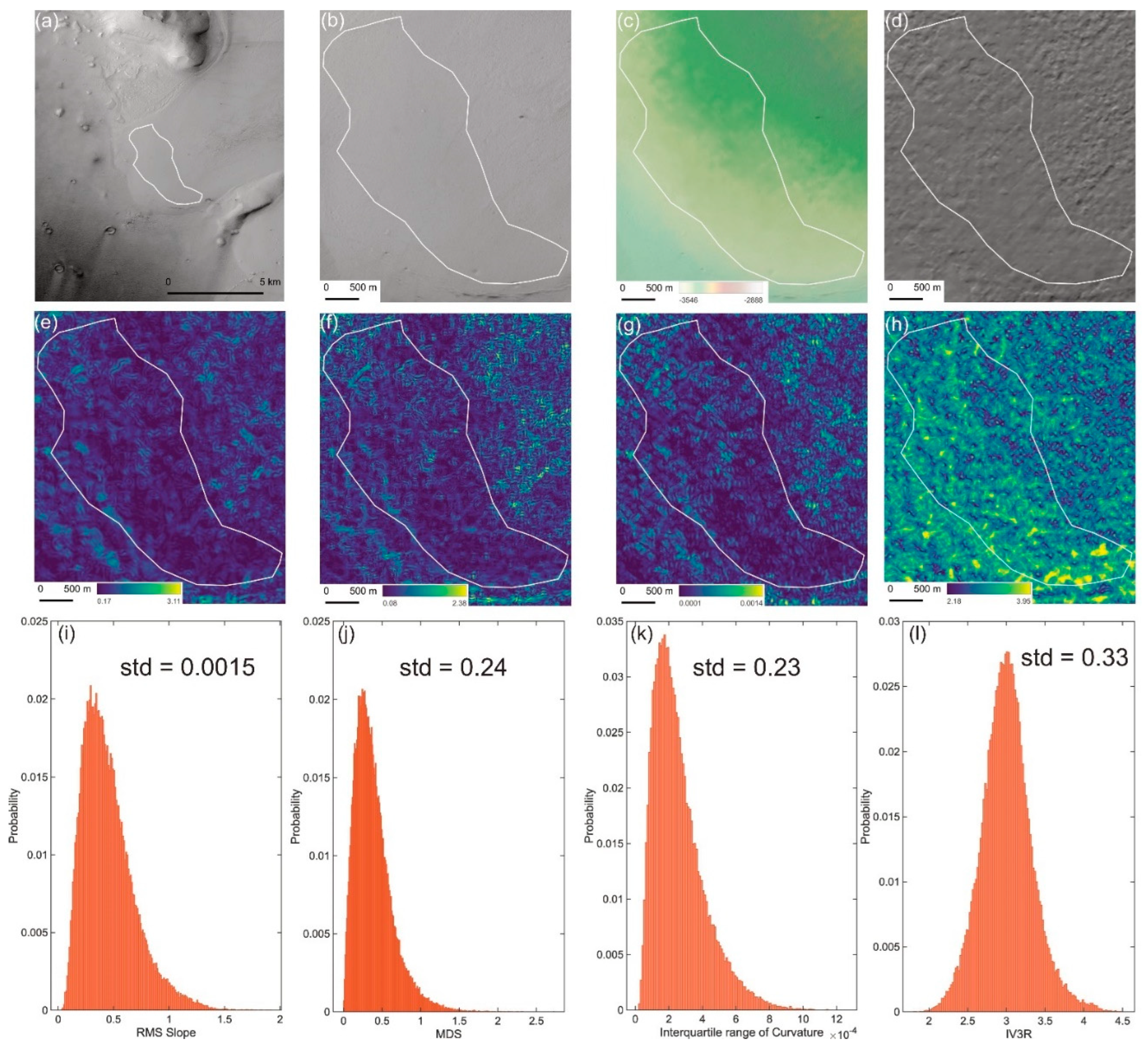
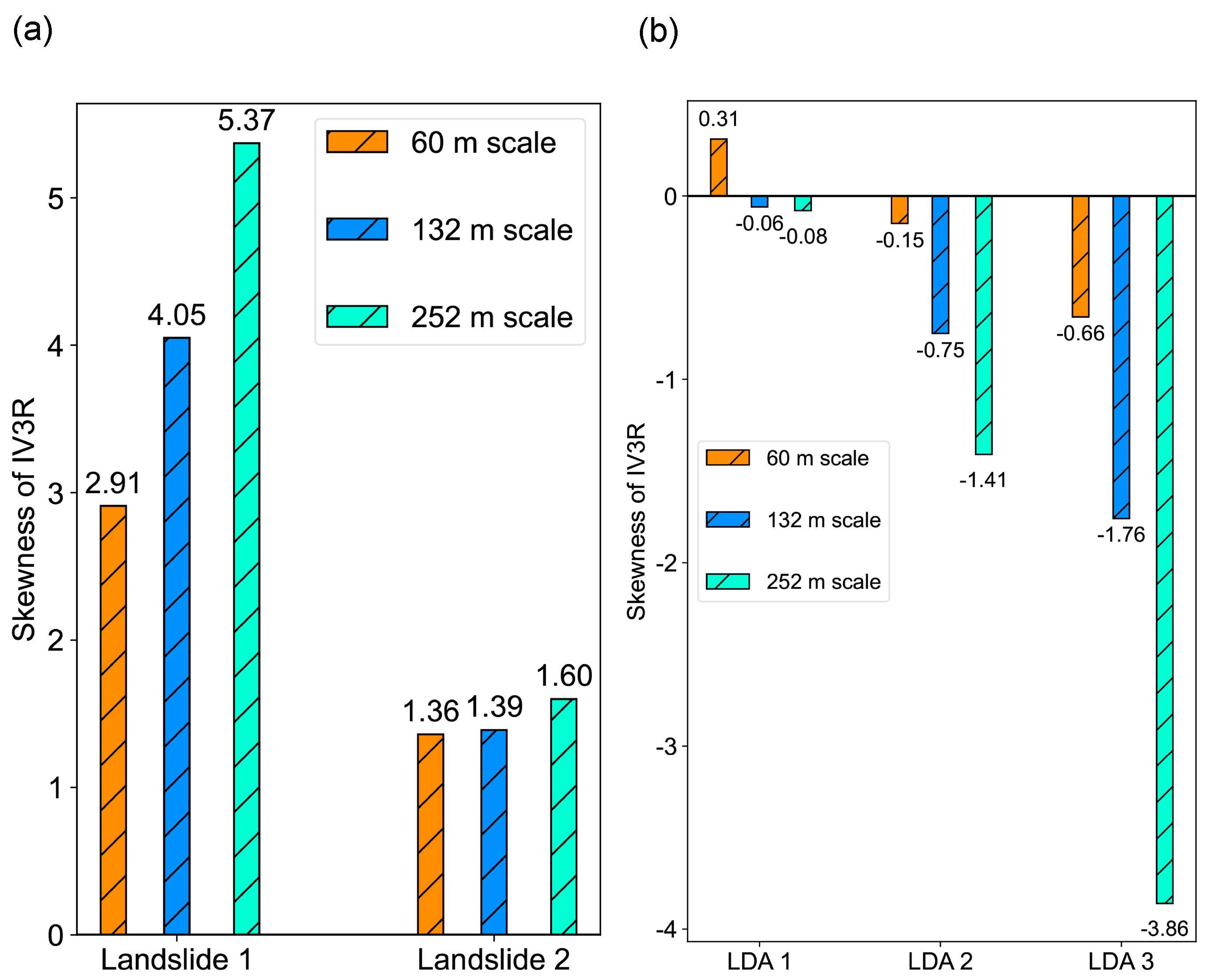
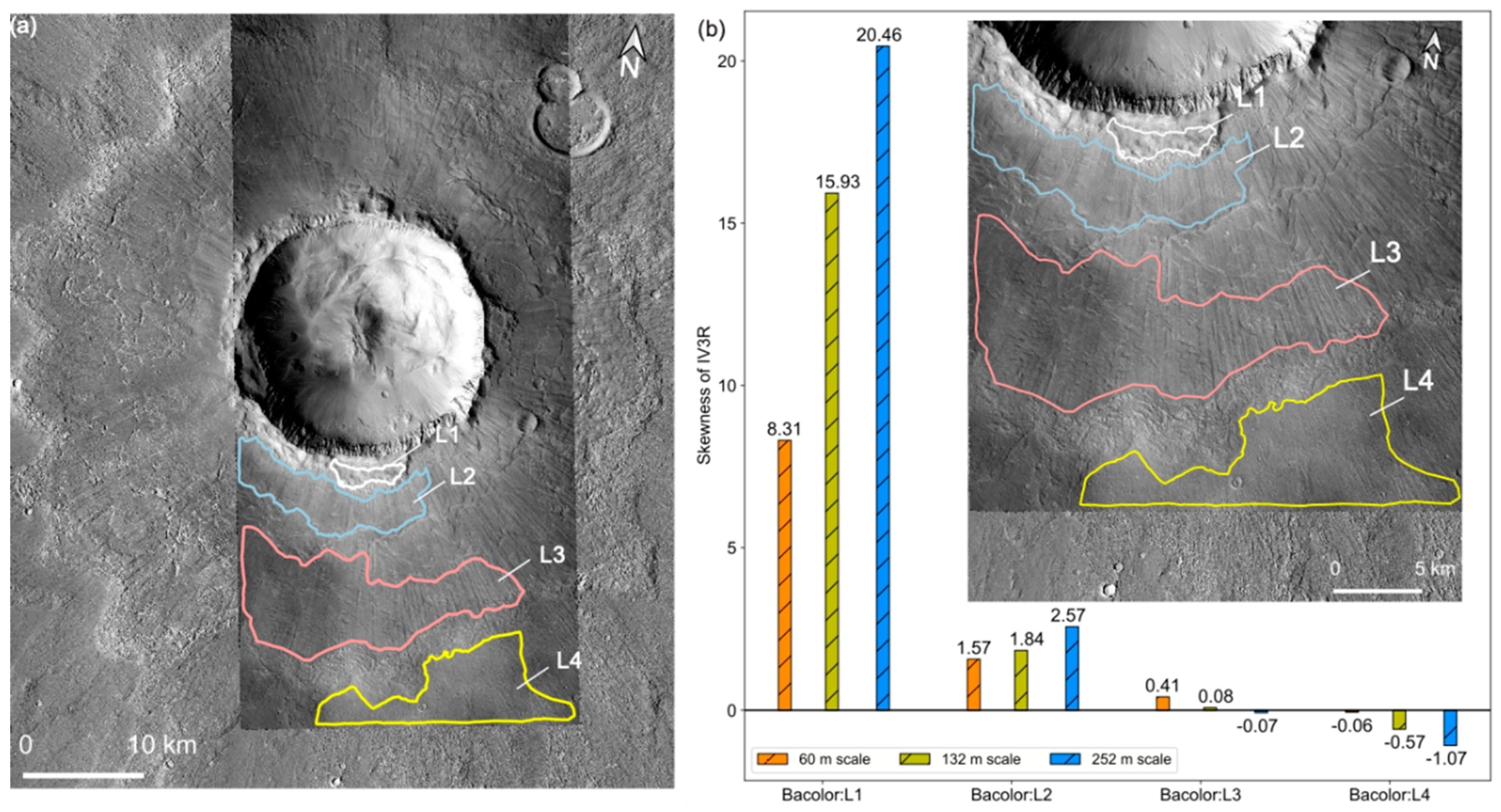
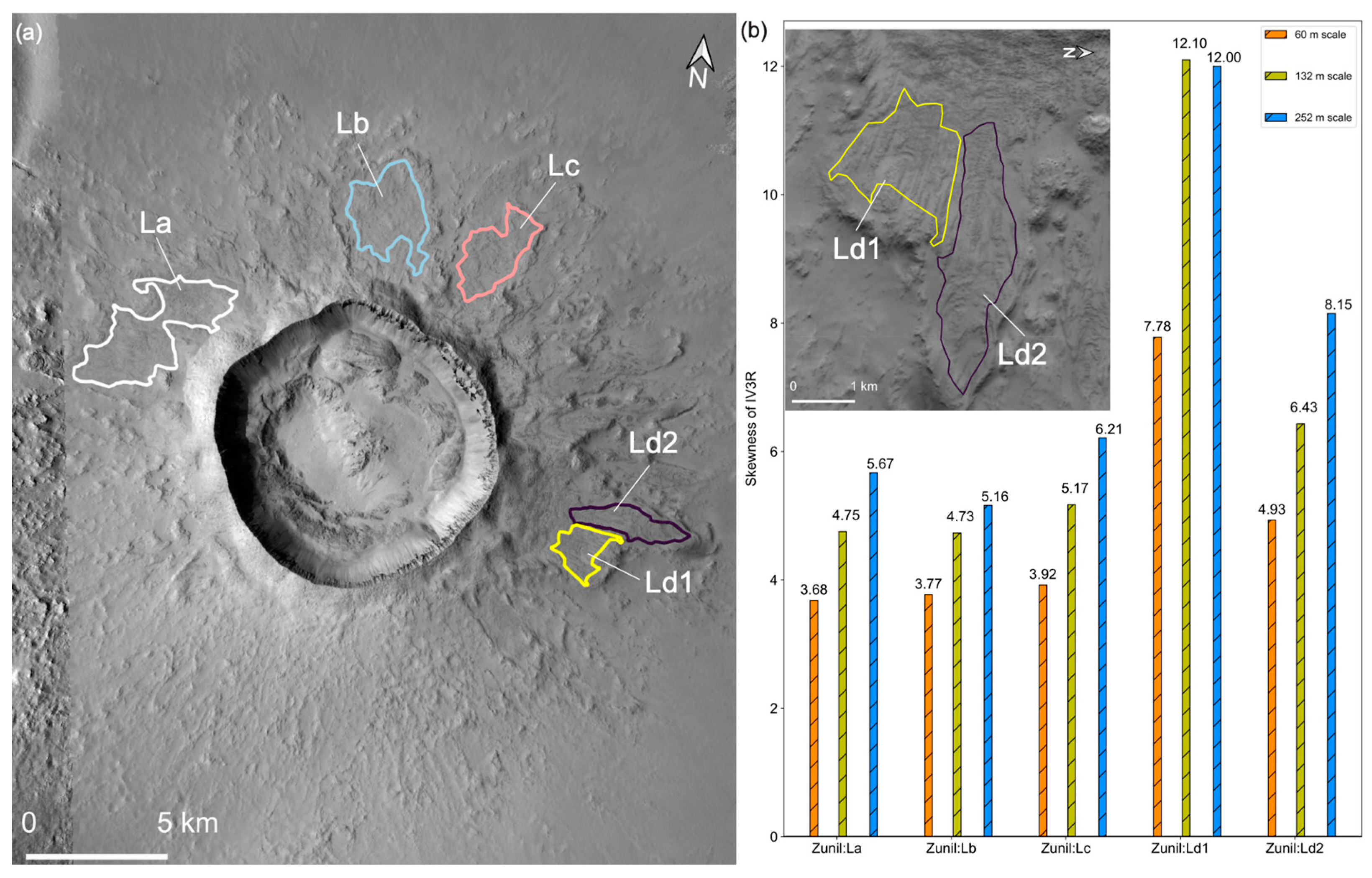
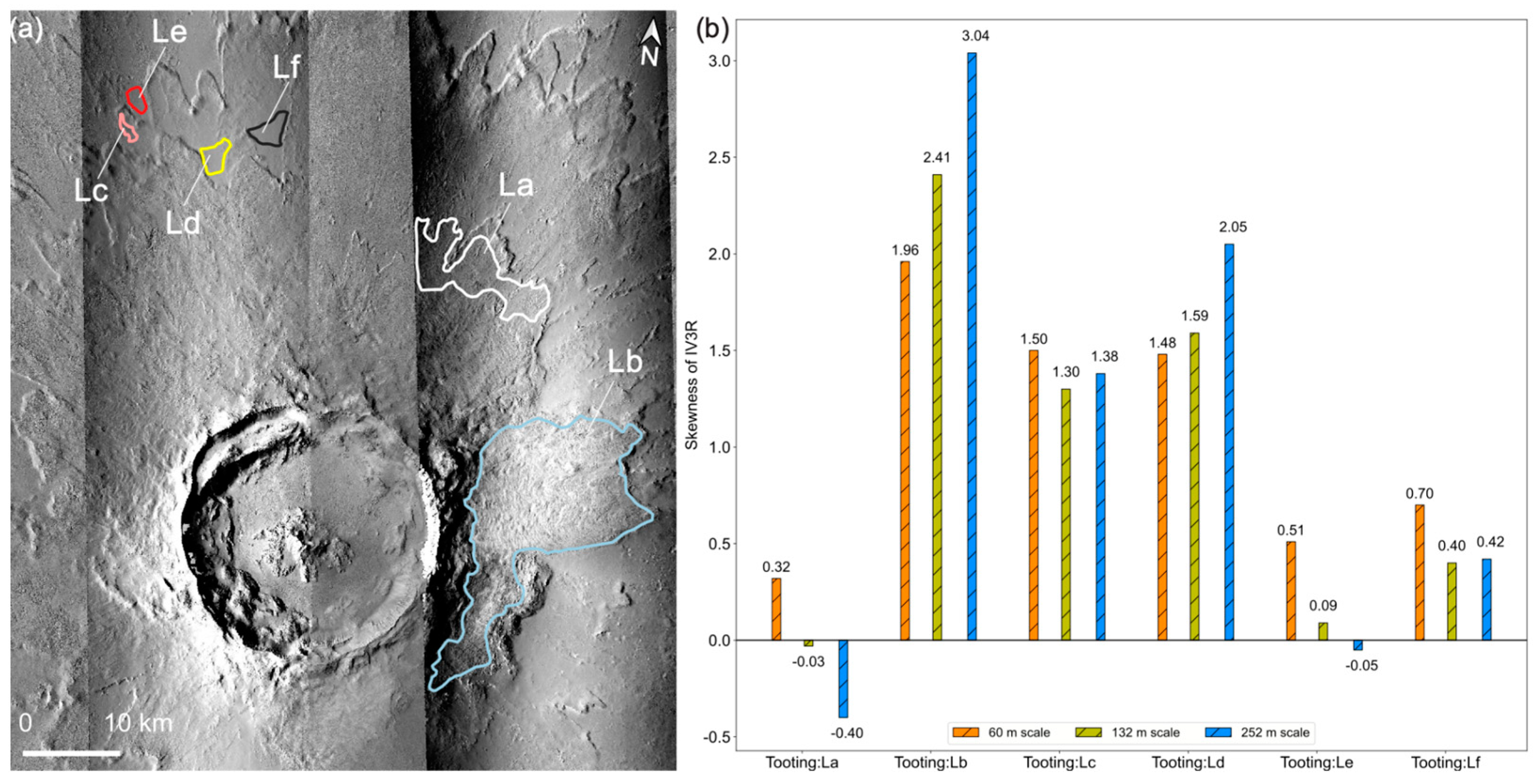
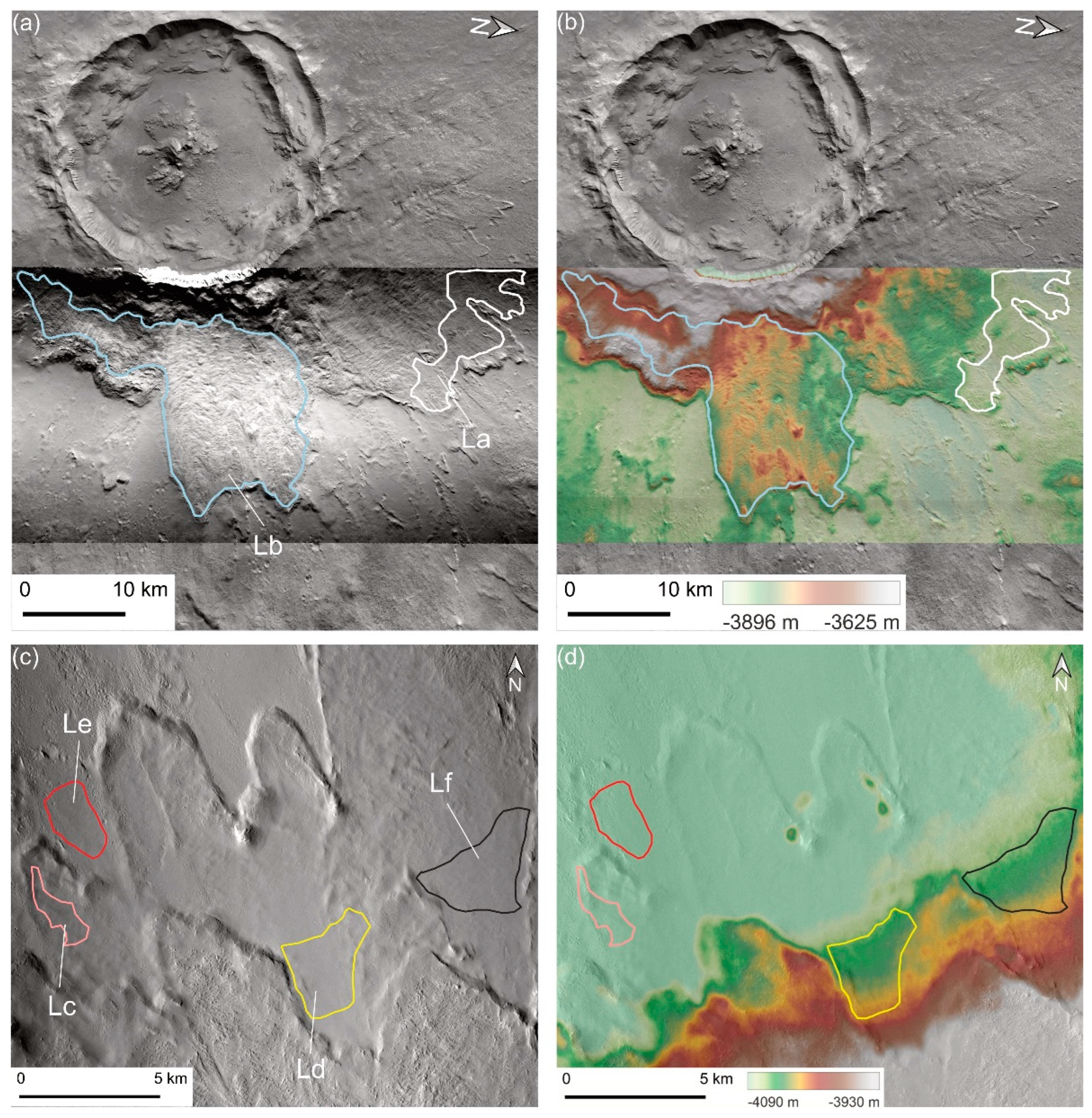
| List | Names and Terrane Types | CTX Stereo-Pair Id * | Location |
|---|---|---|---|
| 1 | LED of Bacolor | CTX_006750_2133_007462_2133 | 33.1°N, 118.7°E |
| 2 | LED of Zunil | CTX_020211_1877_038250_1877 | 7.5°N, 166.1°E |
| 3 | LED of Tooting | CTX_002013_2035_002646_2036; CTX_016280_2037_016425_2037 | 23.1°N, 152.1°W |
| 4 | Landslide 1 | CTX_008181_1676_035384_1682 | 12.3°S, 69.5°W |
| 5 | Landslide 2 | CTX_045868_1722_046580_1715 | 7.9°S, 77.8°W |
| 6 | Lobate debris apron 1 (LDA 1) | CTX_020203_2178_026994_2170 | 40.0°N, 25.0°E |
| 7 | Lobate debris apron 2 (LDA 2) | CTX_008731_2218_024317_2201 | 40.2°N, 24.0°E |
| 8 | Lobate debris apron 3 (LDA 3) | CTX_008731_2218_024317_2201 | 39.8°N, 24.4°E |
Disclaimer/Publisher’s Note: The statements, opinions and data contained in all publications are solely those of the individual author(s) and contributor(s) and not of MDPI and/or the editor(s). MDPI and/or the editor(s) disclaim responsibility for any injury to people or property resulting from any ideas, methods, instructions or products referred to in the content. |
© 2023 by the authors. Licensee MDPI, Basel, Switzerland. This article is an open access article distributed under the terms and conditions of the Creative Commons Attribution (CC BY) license (https://creativecommons.org/licenses/by/4.0/).
Share and Cite
Cao, W.; Xiao, Z.; Luo, F.; Ma, Y.; Xu, R. Comparison of Topographic Roughness of Layered Deposits on Mars. Remote Sens. 2023, 15, 2272. https://doi.org/10.3390/rs15092272
Cao W, Xiao Z, Luo F, Ma Y, Xu R. Comparison of Topographic Roughness of Layered Deposits on Mars. Remote Sensing. 2023; 15(9):2272. https://doi.org/10.3390/rs15092272
Chicago/Turabian StyleCao, Wei, Zhiyong Xiao, Fanglu Luo, Yizhen Ma, and Rui Xu. 2023. "Comparison of Topographic Roughness of Layered Deposits on Mars" Remote Sensing 15, no. 9: 2272. https://doi.org/10.3390/rs15092272
APA StyleCao, W., Xiao, Z., Luo, F., Ma, Y., & Xu, R. (2023). Comparison of Topographic Roughness of Layered Deposits on Mars. Remote Sensing, 15(9), 2272. https://doi.org/10.3390/rs15092272






